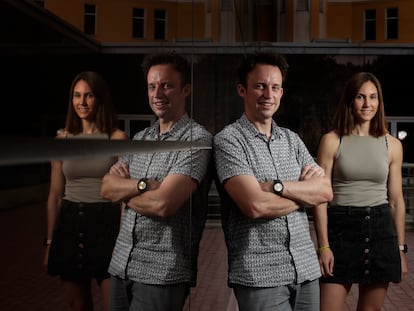Can you increase the strength of a muscle without contracting it?
The nervous system plays a role in activating our muscles, because the brain must send a signal. Can we get stronger by improving it? Some studies suggest so

In a study that was published in a scientific journal in 2014, a group of researchers immobilized one of the wrists of each of the participants for four weeks. They divided the volunteers into two groups: while one didn’t have to do anything, the other went every weekday, Monday to Friday, to the center where the study was being conducted. There they were asked to imagine that they were contracting their forearm muscle and bending their wrist (through sensors they were prevented from actually doing it). After those four weeks, when the splints were removed, all the participants had lost strength in the wrist that had been immobilized, but those that had pictured themselves exercising it had lost less, according to the study, published in Journal of Neurophysiology.
The first step towards understanding this magic where imagining the contraction of the muscle is enough to avoid the loss of strength when a joint is immobilized, is to get a sense of how strength works; that is, what our muscles do in order to raise a dumbbell or a fork, or simply to keep us standing straight. The central nervous system plays a key role in each of these actions.
“Skeletal muscle is not capable of contracting spontaneously; it does it by following the orders that arrive from the nervous system,” says Xavier Navarro, a researcher at the Institut de Neurociències de la Universitat Autònoma de Barcelona (UAB). After being sent out from the central cortex, the order travels through the spinal cord towards the motor neuron or motor neurons that it seeks, from where it will take the path of its axon (an extension of the motor neuron) and the branching off that leads to the muscle fibers that we want to activate. “The combination of a motor neuron, its axon and all the muscle fibers that it innervates is called a motor unit”, explains the expert.
Every muscle is made up of several different-sized motor units. “The degree of muscle contraction depends on the number and type of motor units that are activated at each moment”, notes Navarro. “Slight muscle contractions, which involve little strength, happen through the activation of the smallest motor units, which causes the contraction of some muscle fibers. When we want to increase the strength, the former motor units are joined by the activation of larger motor units, which allows for the contraction of a larger number of muscle fibers. Finally, when the muscle contraction is too intense and the strength has reached its peak, the last motor units to join are the largest ones, and therefore the ones that innervate a larger amount of muscle fibers and can generate the most muscle strength. This mechanism of organized summation of motor units is known as motor unit recruitment”, he explains. The strength that we’re capable of producing with one muscle depends on the length it has when we activate it, our intended shortening speed and the frequency and intensity of the nerve signals that activate it.
Therefore, it is evident that the central nervous system plays a very important role in the strength that we have. When we work with our strength we don’t just use our muscles; in order for the muscle to contract we have to set in motion that entire chain in which the nervous system is in charge, something we do automatically when we make any movement. But is it possible to separate head from muscle (and spine, and nerves) and gain strength without contracting the muscle? Studies like the one mentioned earlier suggest that it is.
Motor Imagery and Unilateral Training
“Certainly, we can increase the strength without contracting the muscle that we want to work on,” claims Gonzalo Márquez, a professor at the Facultade de Ciencias do Deporte e da Actividade Física of the Universidade da Coruña, in northwestern Spain, and a member of the research group on learning and control of human movement in physical activity and sport. The expert points out that there are two strategies for this strength work outside the muscle. One is the one that was used in the study with the immobilized wrists; motor imagery, a “mental simulation of movement with no evident muscle contraction while the person remains at rest.” Through this type of intervention, “it has been proven that it is possible to increase the strength between 5 and 15%,” he says.
The other strategy, which can also sound like magic for the uninitiated, is unilateral training. “When we train an arm or a leg separately, part of the gains achieved in the trained limb are ‘transferred’ to the untrained limb, which is something known as the ‘cross effect’ or ‘interhemispheric transfer’ of strength training,” explains Márquez.
The mechanism that the body uses to increase the strength of an untrained muscle is similar in both cases. “Through techniques of brain imaging,” says the expert, “it has been proven that when we imagine a movement, the part of the brain that is in charge of controlling such movement turns on (activates) in a way that is similar to when we actually do it. Similarly, when we contract one of the limbs, the opposite hemisphere, which controls the limb at rest, is also activated (to a lesser extent). The excitability increases abruptly in the hemisphere that’s not supposed to turn on. We see it every day.” In the long term, this activation, which we’ve worked on through our imagination or unilateral training, will produce “an adaptation in the nervous system that will allow for a more efficient contraction of the muscle, making it able to generate more strength.” That is, we train the part of the nervous system that is necessary to generate strength and the signal reaches better.
That is the same reason why, when a person begins strength training, they tend to notice quick gains long before the muscle starts to grow. There are studies (since the late 1970s) that discuss those adaptations that our nervous system makes and which happen before there are any noticeable effects on the muscle mass. If the first strength gains are produced in the nervous system, it makes sense that it would also be possible to achieve them – albeit in a limited way – by training that part without involving the muscle directly.
Promises for training and rehabilitation
“The scientific literature is putting a lot of interest in investigating whether motor imagery can be effective to improve skills in healthy people, in athletes when intensive training can’t be carried out, and in the rehabilitation of people with neurological or orthopedic pathologies in order to improve pain, joint range or strength,” explains Eva Prado Robles, an occupational therapist at the Complejo Asistencial Universitario de León. The results of most of the studies support the effectiveness of the technique, she explains, although she clarifies that “traditional physical training is still essential and the most effective method to increase strength.” Xavier Navarro sums it up: “If a muscle doesn’t contract, it becomes atrophied.”
In the laboratory, Gonzalo Márquez tries to find out if, just like simple imagination or unilateral training activate the areas of the brain that are involved in movement and improve the results, artificial activation of those areas through neuromodulation techniques would have an effect on performance. By studying resistance in particular, the conclusion is that it would. “We’ve found that, by stimulating the dorsolateral prefrontal area, the volunteers were able to pedal for longer periods,” he indicates. Would this mean more fatigue later, not having felt the need to stop earlier? The expert explains that this isn’t the case. “What this is telling us is that the limit of tolerance to exercise is not the one imposed on a normal task. We have a reserve, the functional reserve. Basically, it is our brain who somehow dictates the end of a task before the organism is actually exhausted,” he says.
So far, they have focused on healthy individuals who are used to training, but the idea is to move on to older people to see if the same effect is achieved. “Their functional capabilities are diminished, largely due to a deteriorated strength. This happens, in part, because there is not a great connection between the nervous system and the muscles. If somehow we’re able to boost the nervous system, we can accelerate the training process and reap benefits sooner,” he explains. This can lead to a better quality of life. “For a person to notice that a task is not as hard, for them to notice more ease for a movement. It is also important for people with a pathology. For someone who had a stroke, picking up a fork can be a challenge,” she says.
All this research paints a very promising picture, but one that is still in the making. Eva Prado Robles points out that not all studies have yielded the same results. She thinks that it is very important to consider the methodological aspects of each one and to design new, broader research that takes everything into account. Aspects like “the planning of the sessions, the measurements, the method, the imagined tasks, the ability to imagine, who it is applied to, the mental effort and the fatigue when executing the mental practice, the complexity and duration of the imagined gesture, the repetitions, the difficulty to visualize or the intrinsic motivation” can affect the result.
Xavier Navarro, from the UAB, agrees. “Most of these studies are short-term,” he observes, and not all of them find that sought-after result of an increase in strength. The same researchers who carried out the study of the immobilized wrists didn’t find it in a first investigation (due to a very limited sampling of volunteers, according to them). Still, Navarro, who is also an advisor at the Guttmann Institute of Neurorehabilitation, believes that it could be a good idea to create programs that motivate the patients and seek that result. “I believe that, if it is explained to the subjects, be it because they want to enhance their performance or because they’re patients, the fact that they know that it [an increase in strength] happens, along with a suitable program, could help them reach that improvement that some studies have proved,” he observes, although he insists on the importance of a specific program.
Unilateral training is also already being used in the world of sports to avoid losing all the functionality of an injured limb, says Gonzalo Márquez, citing badminton player Carolina Marín as an example.
Everyone agrees that more and broader studies are necessary, but the seed of the possibility has already been planted. As Xavier Navarro summarizes, “our circuitry is complex.” Knowing it better will lead to new therapies, better training and an easier life for many people.
Tu suscripción se está usando en otro dispositivo
¿Quieres añadir otro usuario a tu suscripción?
Si continúas leyendo en este dispositivo, no se podrá leer en el otro.
FlechaTu suscripción se está usando en otro dispositivo y solo puedes acceder a EL PAÍS desde un dispositivo a la vez.
Si quieres compartir tu cuenta, cambia tu suscripción a la modalidad Premium, así podrás añadir otro usuario. Cada uno accederá con su propia cuenta de email, lo que os permitirá personalizar vuestra experiencia en EL PAÍS.
¿Tienes una suscripción de empresa? Accede aquí para contratar más cuentas.
En el caso de no saber quién está usando tu cuenta, te recomendamos cambiar tu contraseña aquí.
Si decides continuar compartiendo tu cuenta, este mensaje se mostrará en tu dispositivo y en el de la otra persona que está usando tu cuenta de forma indefinida, afectando a tu experiencia de lectura. Puedes consultar aquí los términos y condiciones de la suscripción digital.
More information
Últimas noticias
NASA discovers Titan doesn’t have an ocean, but a ‘slushy ice layer’ that increases possibility of life
Innocence lost in the forest of the child soldiers: ‘Each leader of the armed group had his girls’
‘Fallout’ or how the world’s largest company turned an anti-capitalist apocalyptic Western into a phenomenon
From inflation to defending migrants: Eileen Higgins and Zohran Mamdani inaugurate the new Democratic resistance against Trump
Most viewed
- ‘El Limones’ and the growing union disguise of Mexican organized crime
- Christian Louboutin: ‘Young people don’t want to be like their parents. And if their parents wear sneakers, they’re going to look for something else’
- The low-cost creative revolution: How technology is making art accessible to everyone
- ‘We are dying’: Cuba sinks into a health crisis amid medicine shortages and misdiagnosis
- Liset Menéndez de la Prida, neuroscientist: ‘It’s not normal to constantly seek pleasure; it’s important to be bored, to be calm’










































